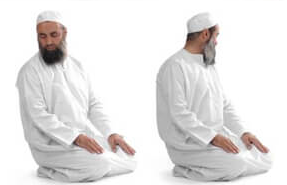Prayer is an essential part of Islamic worship and an important daily practice for Muslims. It helps to establish a connection with Allah, bring peace and tranquillity to the heart, and provide a means of expressing gratitude and seeking guidance. In this post, we will explore the basics of how to pray in Islam, including the steps involved and what each part of the prayer represents.
Preparation for prayer in Islam involves both physical and spiritual readiness. It is important to ensure that you are clean and free of impurities before beginning the prayer. This can be accomplished by washing the hands, mouth, nose, face, arms, head, and feet (known as Wudu or ablution), or by taking a full shower (known as Ghusl).
In terms of spiritual preparation, it is important to make the intention to pray and focus the mind on the act of worship.
It is also important to face the Kaaba in Mecca when praying, as this symbolizes facing Allah and acknowledging His presence. This can be done by physically facing the Kaaba if one is in Mecca, or by using a compass to determine the direction from one’s location.
In summary, preparation for prayer in Islam involves physical cleanliness, making the intention to pray, and facing the Kaaba. By properly preparing for prayer, we can approach the act of worship with a clean and focused state of mind, allowing us to connect with Allah and receive the full benefits of prayer.
Intention (niyyah in Arabic) is a crucial aspect of prayer in Islam. It is the innermost desire and purpose behind performing the prayer, and it is considered to be one of the pillars of prayer. The Prophet Muhammad (peace be upon him) said: “Actions are only by intention, and every person will only get what they intended.”
The intention to pray is made silently in one’s heart, before the start of the prayer. This intention sets the tone for the prayer and serves as a reminder of the purpose behind the act of worship.
The intention to pray must be made with sincerity and to please Allah. It should not be made as a mere formality or out of habit, but rather as a conscious and deliberate choice to connect with Allah.
In addition to setting the tone for the prayer, the intention also helps to focus the mind and heart on the act of worship. By making the intention to pray, the believer can enter into the prayer with a clear and focused state of mind, allowing them to connect with Allah and receive the full benefits of prayer.
In summary, the intention is an important aspect of prayer in Islam and serves as a reminder of the purpose and focus of the act of worship. It should be made with sincerity and to please Allah, and it helps to set the tone and focus the mind and heart on the prayer.
Takbir (the declaration of faith “Allahu Akbar”) is the first step in the prayer process in Islam. It is a declaration of the greatness and superiority of Allah and serves as a reminder of the purpose of prayer – to establish a connection with Allah and acknowledge His presence.
The takbir is said with the hands raised to the ears and is a signal to the rest of the body and mind that the prayer is about to begin. It serves as a transition from worldly concerns and distractions to the spiritual focus of prayer.
In addition to serving as a declaration of faith, the takbir is also a means of focusing the mind and purifying the heart. By saying the takbir, the believer is reminded of the importance of focusing on Allah and the purpose of prayer and can enter into the prayer with a clear and focused state of mind.
The takbir is also a way of showing humility and submission to Allah, acknowledging that He is greater than any of our worldly concerns and distractions. By declaring the greatness of Allah, we can focus on Him and connect with Him more deeply.
In summary, the takbir is an important part of the prayer process in Islam, serving as a declaration of faith, a means of focusing the mind and purifying the heart, and a reminder of the importance of humility and submission to Allah.

Qiyam (standing) is one of the physical postures in the prayer process in Islam. It is a symbol of respect and submission to Allah, as well as a demonstration of the believer’s physical and spiritual readiness for prayer.
Qiyam is performed after making the intention to pray and saying the takbir (declaration of faith “Allahu Akbar”). During the qiyam, the believer stands with the hands raised to the ears and recites verses from the Quran. This posture helps to focus the mind and heart on the prayer and establishes a connection with Allah.
In addition to the physical posture, qiyam also involves spiritual readiness and humility. The believer must approach the prayer with a sense of humility and submission to Allah, acknowledging that He is greater than any of our worldly concerns and distractions. This helps to purify the heart and focus the mind on the act of worship.
In some cases, individuals may not be physically able to stand during the prayer. In such cases, they may perform the qiyam by sitting or prostrating, depending on their level of physical ability. The important thing is to approach the prayer with a sense of humility and submission to Allah, regardless of the physical posture.
In summary, qiyam is an important part of the prayer process in Islam, serving as a symbol of respect and submission to Allah, a demonstration of the believer’s physical and spiritual readiness for the prayer, and a means of focusing the mind and heart on the act of worship.
Recitation of Al-Fatiha, also known as the “Opening Chapter,” is an integral part of the prayer in Islam. It is the first chapter of the Quran and is considered to be one of the most important chapters in the book.
Al-Fatiha is recited in every rak’a (unit) of the prayer and serves as a declaration of faith in Allah and a recognition of His guidance and blessings. The chapter begins with the declaration of the greatness of Allah and continues with a series of supplications and praises to Allah, asking for His guidance and protection.
In addition to its role in prayer, Al-Fatiha is also considered to be a summary of the entire Quran and a declaration of the essence of Islam. By reciting Al-Fatiha, the believer is acknowledging the greatness of Allah and affirming their faith in Him and His guidance.
In terms of its benefits, Al-Fatiha is believed to provide protection and guidance to the believer, as well as increase their connection with Allah. Reciting Al-Fatiha is also said to provide spiritual nourishment and to be a source of blessings and rewards from Allah.
In summary, the recitation of Al-Fatiha is an important part of the prayer in Islam, serving as a declaration of faith in Allah, a recognition of His guidance and blessings, and a means of increasing the connection with Allah.
Listen to Sura al Fatiha:
Meaning of Sura al Fatiha:
1. In the Name of Allah, the Most Beneficent, the Most Merciful.
2. All the praises and thanks be to Allah, the Lord of the ‘Alamin (mankind, jinns and all that exists).
3. The Most Beneficent, the Most Merciful.
4. The Only Owner (and the Only Ruling Judge) of the Day of Recompense (i.e. the Day of Resurrection)
5. You (Alone) we worship, and You (Alone) we ask for help (for each and everything).
6. Guide us to the Straight Way
7. The Way of those on whom You have bestowed Your Grace, not (the way) of those who earned Your Anger (such as the Jews), nor of those who went astray (such as the Christians).

Ruku (bowing) is one of the physical postures in the prayer process in Islam. It is a demonstration of humility and submission to Allah and is performed as a means of acknowledging His greatness and seeking His guidance and blessings.
During the ruku, the believer bows down and places their hands on their knees, while supplicating. This posture helps to focus the mind and heart on the prayer and to establish a deeper connection with Allah.
In addition to its physical aspects, ruku also involves spiritual humility and submission to Allah. The believer must approach the ruku with a sense of humility, acknowledging that Allah is greater than any of our worldly concerns and distractions. This helps to purify the heart and focus the mind on the act of worship.
In summary, ruku is an important part of the prayer process in Islam, serving as a demonstration of humility and submission to Allah and a means of acknowledging His greatness and seeking His guidance and blessings. It helps to focus the mind and heart on the prayer and to establish a deeper connection with Allah.
Ruku (Bowing): Bending at the waist, with your hands on your knees, and saying “Subhana rabbi al-Azim” (Glory to my Lord, the Exalted).

Sujud (prostration) is one of the physical postures in the prayer process in Islam. It is a demonstration of humility and submission to Allah and is performed as a means of acknowledging His greatness and seeking His guidance and blessings.
During the sujud, the believer places their forehead, nose, hands, knees, and feet on the ground, while reciting supplications. This posture helps to focus the mind and heart on the prayer and to establish a deeper connection with Allah.
In addition to its physical aspects, sujud also involves spiritual humility and submission to Allah. The believer must approach the sujud with a sense of humility, acknowledging that Allah is greater than any of our worldly concerns and distractions. This helps to purify the heart and focus the mind on the act of worship.
Sujud is considered to be the most important physical posture in prayer, and it is said to be the closest one can come to Allah in this life. Through the act of sujud, the believer seeks to humble themselves before Allah and to seek His guidance and blessings.
In summary, sujud is an important part of the prayer process in Islam, serving as a demonstration of humility and submission to Allah and a means of acknowledging His greatness and seeking His guidance and blessings. It helps to focus the mind and heart on the prayer and to establish a deeper connection with Allah and is considered to be the most important physical posture in the prayer.
After the first Sujud, the prayer goes to a sitting position, then goes to a second sujud.
During the sujud, we say “subhana Allah Rabi al Ala” which mean Glorified be my Lord, the Most Exalted”
After the Ruku, it is mandatory to come back to the position of Qiyam and then to go to sujud.
The sitting position after sujud is an important part of the prayer process in Islam. It serves as a transition between the physical postures of the prayer and is performed as a means of reflecting on the prayer and seeking Allah’s guidance and blessings.
During the sitting position, the believer sits on the ground with their legs crossed and their hands resting on their thighs. This posture helps to focus the mind and heart on the prayer and to establish a deeper connection with Allah.
In addition to its physical aspects, the sitting position after sujud also involves spiritual reflection and contemplation. The believer is encouraged to reflect on their prayer and to seek Allah’s guidance and blessings, seeking to deepen their connection with Him.
In summary, the sitting position after ruku is an important part of the prayer process in Islam, serving as a transition between the physical postures of the prayer and as a means of reflecting on the prayer and seeking Allah’s guidance and blessings. It helps to focus the mind and heart on the prayer and to establish a deeper connection with Allah.
After the sitting position on the knee, the prayer will make a second sujud.

The second Raka of the prayer in Islam is performed in much the same way as the first raka. It involves repeating the physical postures and recitations that were performed in the first raka, with some minor variations.
To perform the second raka, the believer starts by standing up from the sitting position after the second sujud. They then recite the takbir (the declaration of the greatness of Allah) and proceed to perform the ruku as they did in the first raka.
After the ruku, the believer then stands up and recites supplication, before performing the first sujud. After the sujud, he sits and then performs the second sujud in much the same way as the first sujud.

Tashahhud is an important part of the prayer process in Islam and is performed towards the end of each raka. It is a testimony of faith and a declaration of one’s belief in the oneness of Allah and the prophethood of Prophet Muhammad, peace be upon him.
During the tashahhud, the believer sits on the ground with their legs crossed and their hands resting on their thighs. They recite a specific set of verses that testify to the oneness of Allah and the prophethood of Prophet Muhammad, peace be upon him.
In addition to its spiritual significance, the tashahhud also serves as a time for reflection and contemplation. The believer is encouraged to reflect on their prayer and to seek Allah’s guidance and blessings, seeking to deepen their connection with Him.
In summary, tashahhud is an important part of the prayer process in Islam, serving as a testimony of faith and a declaration of one’s belief in the oneness of Allah and the prophethood of Prophet Muhammad, peace be upon him. It also serves as a time for reflection and contemplation and is followed by the final salams, in which the believer seeks Allah’s peace and blessings.
The tashahhud is followed by the final salams.

Salam is the Islamic term for peace, and it is also a common greeting used by Muslims. In the context of prayer in Islam, salam refers to the final stage of the prayer.
The salam is performed by turning the face to the right and then to the left while saying “as-salamu alaykum” (peace be upon you) each time. This act symbolizes the believer’s greeting to all of Allah’s creations, seeking peace and blessings not just for themselves, but for all of humanity.
The salam is an important part of the prayer process in Islam, serving as a reminder of the importance of seeking peace and blessings for oneself and others. It also serves as a reminder of the interconnectedness of all things and the importance of treating others with respect and compassion.
End the prayer by saying “As-salaamu alaykum wa rahmatullah” (Peace be upon you and the mercy of Allah) and turn your head to the right and then to the left.
Each part of the prayer serves a specific purpose and is an opportunity to focus on different aspects of our relationship with Allah. The takbir is a declaration of faith, while the recitation of Surah Al-Fatihah is a reminder of the importance of seeking guidance and support from Allah. Bowing and prostration serve as acts of humility and submission, and the Tashahhud is a time to make du’a and reflect on the blessings we have received from Allah.
In addition to the steps outlined above, there are certain rules and etiquette that should be observed when praying in Islam. For example, it is important to be mindful of your appearance, wear clean and modest clothing, and maintain a peaceful and focused state of mind during prayer.
It is also recommended to pray at regular intervals throughout the day, including the five daily prayers (Fajr, Dhuhr, Asr, Maghrib, and Isha), as well as performing extra prayers such as Tarawih during Ramadan.
In conclusion, prayer is a crucial part of Islamic worship and an opportunity to connect with Allah and seek guidance and support in our daily lives. By understanding the steps and importance of prayer, we can deepen our relationship with Allah and lead a more fulfilling and meaningful life. May Allah grant us the ability to pray with sincerity and devotion, and may He accept our prayers and grant us His blessings and guidance.
If you are a new muslim or interested to convert to islam, you can read our post: how to convert to Islam
Book your free trial lesson
In addition to the free Arabic courses, we offer you to begin your journey to fluency in Arabic right now for free with a graduated Egyptian teacher.

Al-dirassa Institute offers you a gift to help you begin your journey to being fluent in Arabic and learning the Quran.

Al-dirassa Institute offers you a gift to help you begin your journey to being fluent in Arabic and learning the Quran.